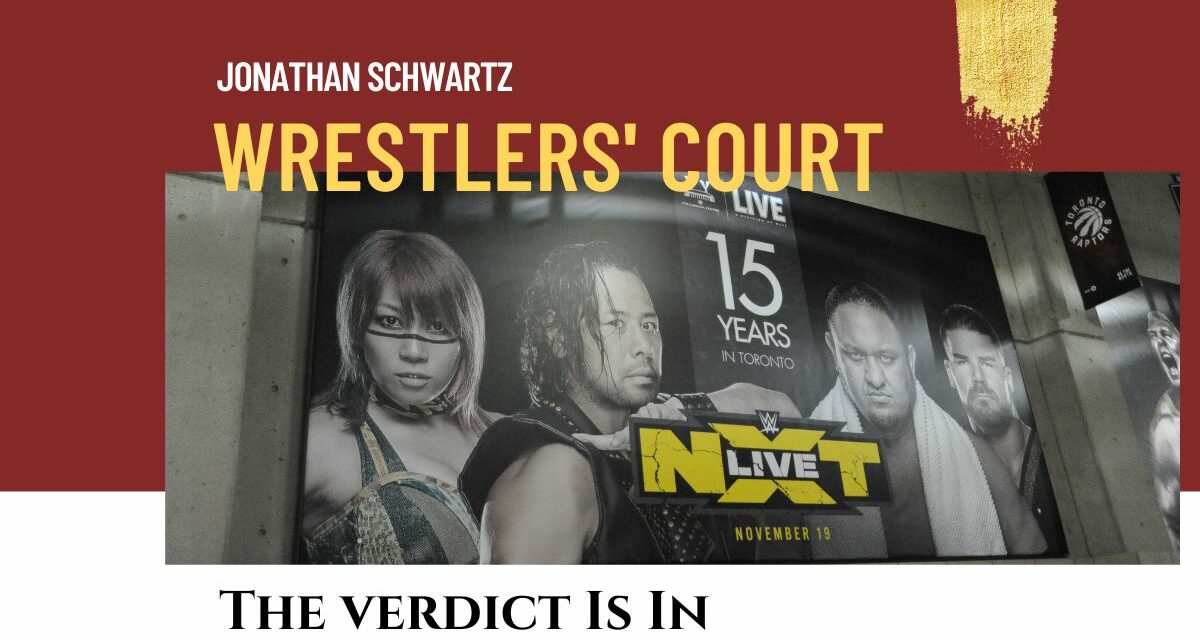I try not to write about the business of professional wrestling too often, even if I think it helps one understand the decisions which affect what we see on our television screens and in arenas.
For one thing, I often feel out of my depth on the subject. My interests lie in storytelling, arguing, problem solving and writing-the usual legal/policy stuff.
For another, I write this column with a particular person in mind: my father. My dad introduced me to wrestling and our shared fandom has always been an important part of our relationship. Growing up wrestling was a shared language and a way to communicate even when things were otherwise strained.
I imagine that many families have similar touchpoints. If you’ve ever read or watched Field of Dreams and remember the “It’s baseball, Ray” speech you know what I mean. I’m a baseball fan too, but my local Toronto Blue Jays have been too long out of contention for those conversations to be as much fun.
In any case, I write these columns with my Dad in mind, and I consider his feedback — which frequently includes suggestions to focus more on wrestling and less on the legal or cultural or business sides of things.
I’m about to disappoint him with this column. Hardly the first time, but sometimes you just go where the story takes you.
Hopefully you, Constant Reader, will enjoy this column.
On November 7, WWE announced that it would be moving its NXT television show to the broadcast CW Network from its current home on basic cable, at the USA Network. The switch will take place once NXT’s current contract with USA ends in September 2024, and will run for five years. The deal is worth an estimated $20-25M to WWE.
If you follow such things, this is big news. The CW is available in over 100 million homes across the US, in contrast to cable outlets like USA (which is the current home of RAW and the future home of SmackDown). There is even talk of turning NXT into its own touring company in order to secure bigger, more camera-ready audiences like you see on WWE’s flagship shows (or AEW’s on a good day).
NXT’s move to network television comes at an interesting time for WWE. Following its acquisition by Endeavor, WWE has also announced that SmackDown, which has aired on the bigger FOX network since 2019, will return to cable — signing a $1.4B deal to move to USA Network — RAW’s current home, starting in October 2024. SmackDown’s move follows disparaging comments from FOX network brass, who claimed the Friday wrestling show failed to meet advertising revenue targets, and sniffed that this failure was due to the low-class nature of pro wrestling fans.
I resemble that remark.
Funnily, RAW is rumored to be moving to FOX’s sister FX network, home of shows like American Horror Story, What We Do in the Shadows, and Feud — all of which might be suitable McMahon family biopic names.
Funnier still, the NXT announcement comes on the heels of one of the stranger wrestling/media stories in recent memory. Recently, National Wrestling Alliance (NWA) president Billy Corgan announced plans were in the works to debut a pair of NWA shows on ‘a top 20 network’. It was believed that said network was the CW. The NWA would air a version of its weekly POWERRR show plus a reality-type project which may or may not have featured Mr. Corgan’s recent wedding. Details were sketchy, including whether this content represented an investment by the network in the NWA or was pay for play, and whether the shows would air on the network itself or via its streaming services. Whatever the deal may have been, it was seemingly thrown into jeopardy by last weekend’s NWA Samhain pay-per-view, which featured an out-of-ring skit where characters were purportedly doing lines of cocaine. Apparently, this drew the ire of the dozens watching, who felt that the skit was more offensive than current CW shows like FBOY Island and contacted the network to voice their concerns for America’s youth. Corgan insists his plans continue unabated and WWE insiders claim their deal with the CW (which had allegedly pursued AEW for a show about a year ago) has been in the works for months. Such is wrestling, and life.
If true, I’m reminded of ECW’s ill-fated run on TNN. In 1999 ECW owner Paul Heyman had signed a three-year contract with the then-Nashville Network in the hopes of taking his edgy wrestling company *ahem* national. TNN stood to benefit from programming targeted to a younger male audience, alongside RollerJam and Rock ‘n’ Bowl.
It was a bad marriage from the start, as TNN executives sought to tone down the raunchy ECW content that brought in their core audience. TNN was also bothered by ECW’s difficulties in retaining top names such as Taz, and by the relatively low-budget appearance of ECW broadcasts despite the network’s lack of investment in improving the show. ECW would air on TNN for a little over a year. TNN is now seen as using ECW as a stalking horse for a deal with the WWE, which would move to that network in late-September 2000 as part of its relaunch as The National Network … later relaunched as Spike TV and later still as Paramount Network. And you think wrestling storylines are confusing. Sheesh.
It’s an academic discussion up here in Canada. We get most of our pro wrestling from one of two main cable sports networks, and a whole bunch of smaller promotions on the upper-tier Fight Network (which also shares a parent company with and broadcasts Impact Wrestling).
Back to the wrestling. Kinda.
NXT has undergone several transformations as a TV show and as a brand. It was created after WWE decided to shutter its poorly-received ECW revival. NXT was originally positioned as a cross between a traditional professional wrestling program and a reality show along the lines of WWE’s earlier Tough Enough series. Instead of recruiting aspiring superstars via video submissions, NXT pulled its characters from Florida Championship Wrestling (FCW), which at the time was overseen by Steve Keirn and operated as a developmental territory for the ‘E’. The FCW wrestlers competed to become WWE’s next ‘breakout’ star, although true to most reality shows, the few stars who were created were more likely the also-rans than the winners. The competitors were paired with mentors from the main RAW and SmackDown rosters, which lent itself to scripted storylines when sets of mentors or mentees didn’t get along, or where friction arose between those who’d been paired off.

Who remembers Nexus?
This version of NXT ran for five seasons. If you’re ever invited to a wrestling trivia night, four winners were crowned: Wade Barrett, Kaval (aka Low-Ki), Kaitlyn and Johnny (Fandango) Curtis.
Kaval flamed out early; he’s acquired a negative reputation backstage throughout his career which has overshadowed his considerable in-ring skills.
Barrett was a multiple-time Intercontinental Champion and would go on to lead the NEXUS faction (and less memorably the CORRE and League of Nations stables), and probably had the best run of the lot. He returned to WWE after a long absence, working commentary first in NXT then on SmackDown and now RAW.
I still use his baritone “I’m afraid I’ve got some bad news for you” catchphrase in meetings at work. I’m the only wrestling fan at my office. I don’t get invited out for after-work drinks.
Kaitlyn would win a Divas championship but has been out of the business for a while, reinventing herself as a personal trainer and wellness coach.
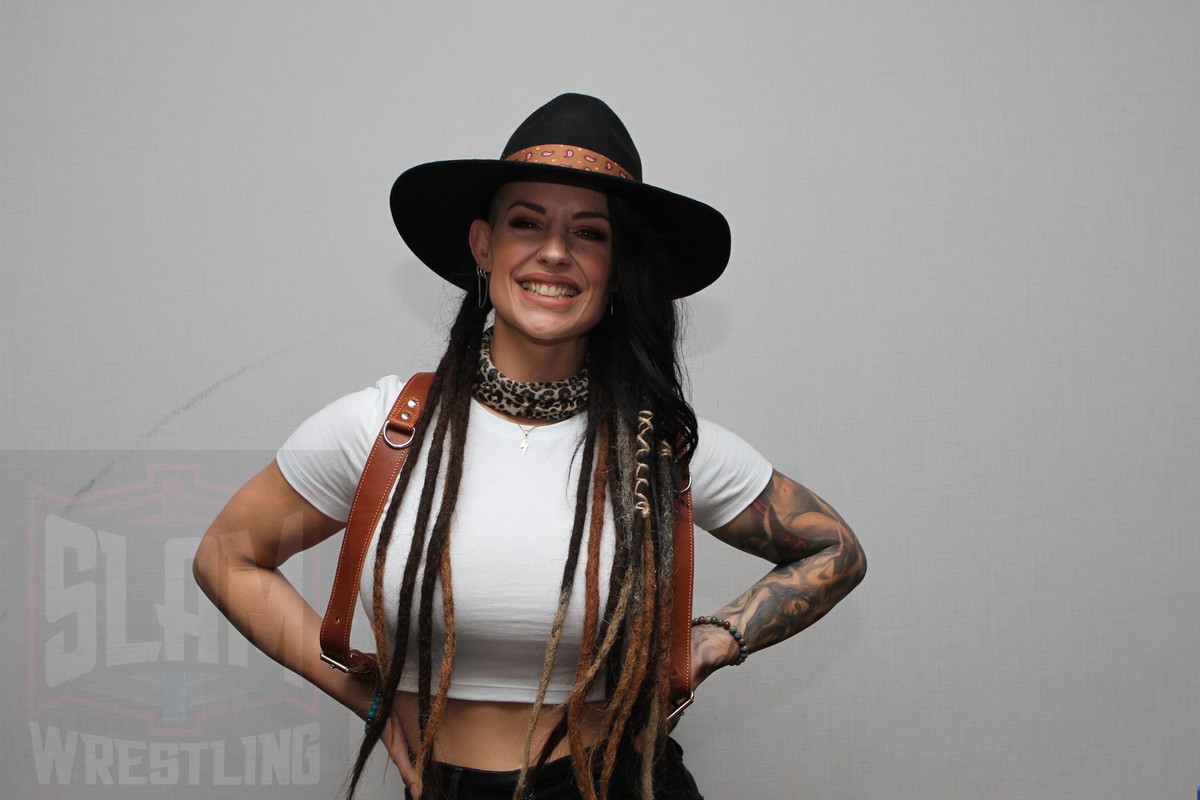
Celeste Bonin fka Kaitlyn at the Legends of the Ring fan fest on Saturday, October, 2, 2021, at the Apa Hotel, Iselin, NJ. Photo by George Tahinos, https://georgetahinos.smugmug.com
Curtis spent years on house shows in near anonymity before he was given the Fandango gimmick. It was terrible camp, but he somehow made it work. A later pairing with Tyler Breeze as the Fashion Police yielded some magically hilarious backstage vignettes and a brief NXT tag title run. The hilarity of their characters concealed the fact that both men were very good wrestlers. Handled correctly I always felt they could have been a solid team in the mold of the old Midnight Express … or at least they could have played the roles currently held by SmackDown’s Pretty Deadly. Breeze mostly works as a trainer these days and still works for WWE creating online content. Curtis appears as Dirty Dango on Impact, where he’s still worth a look.
Eagle-eyed readers will note that despite there being five official NXT seasons, only four winners were declared. A fifth season began, but never seemed to have an end in sight. It became a running joke, even though it often featured great matches and offered underused main roster performers a platform to show their talents. In June 2012, WWE decided to stop treating NXT like a wrestling version of American Idol and retooled the show as a straight-ahead showcase for its developmental talent.
I am ambivalent about WWE’s positioning of NXT. As a wrestling fan, I greatly appreciate the longer-form, higher intensity matches which NXT has often featured. A hallmark of NXT broadcasts is its use of smaller, more intimate venues to bring fans close to the action, first on the Full Sail University Campus and now from the WWE’s own Performance Centre training facility. TV tapings now take place in a dedicated venue that mimics WWE’s arena set up, entrance, camera angles and all, called the Capitol Wrestling Centre. This approach may cultivate a repeat audience — one that is engaged in storylines and has been trained in how to react — similar to ECW at its eponymous arena, Lucha Underground and its Aztec Temple or the Sportatorium or ballrooms used for TV tapings by promotions back in the territory days.
I appreciate the need for WWE to showcase its newer stars, and to give truly developmental talent the opportunity to practice in front of a live televised audience. I don’t know that NXT has been all that successful in bringing ready-made stars to their broader market. The shows often feature more established talent who can nail a promo or work a quality match from start to finish, but a lot of airtime is taken up by wooden or screechy speeches, and matches that range from clumsy to dangerous by wrestlers who aren’t yet ready for prime time.
Plenty of wrestlers have been called up from NXT only to find themselves struggling on to find their voices on the main roster.
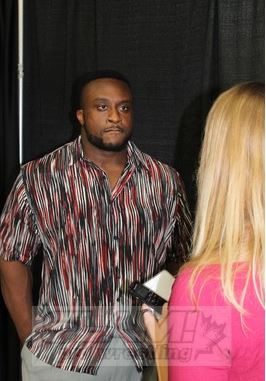
Big E talks with SlamWrestling report Kari Williams. Photo by Greg Oliver
NXT’s second champion was Big E Langston (he later lost his last name). He was a powerhouse heel who appropriated King Kong Bundy’s old ‘five count’ gimmick — even if it was appended to one of my least favorite finishing moves ever. Big E got over with this act but I can’t think of an instance where he used it on the main roster; instead he was a mostly silent bodyguard for Dolph Ziggler, then a bland babyface. He would find a deep well of charisma once teamed with Kofi Kingston and Xavier Woods in the New Day, and would collect tag team, Intercontinental and even the WWE World championships. Big E became a truly compelling wrestler well after his NXT stint, and despite being out of action with a severe neck injury, he’d be my pick to dethrone Roman Reigns as Undisputed Champion with Cody Rhodes waiting in the wings for a heel run.
OG NXT champion Seth Rollins had extensive experience on the independent scene before signing with WWE, including a run with MTV’s failed Wrestling Society X project, and a 200-plus day reign as Ring of Honor World champion as Tyler Black. He and fellow Shield member Roman Reigns were also so inept at promos that when they were brought to the main roster as the Shield, they were joined by Dean Ambrose, who could do the talking for all three men. I still think Rollins is better in ring than on the mic. His current character is aimlessly goofy. People like him and he’s fun to watch when he stops talking and starts wrestling. Roman’s done well for himself too, developing a simmering heel character after years of forced good-guy promos, the worst of which are still referenced by fan favorites looking to take him down a peg — YEAH!
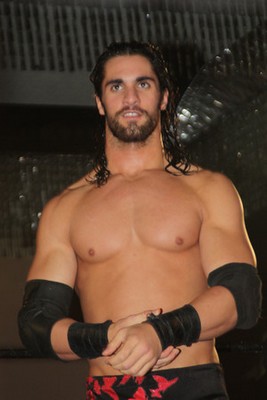
Before he was Seth Rollins, he was Tyler Black in Ring of Honor. SlamWrestling file photo
The wrestling/reality version of NXT debuted on the Syfy network in late February 2010. It was replaced by SmackDown in October and aired instead as a one-hour show on wwe.com. NXT would gain more traction as a standalone wrestling show in 2014, when it would be featured on the new WWE Network streaming service. In 2019, NXT became even more broadly available. In a move seen as counterprogramming against the new All Elite Wrestling (AEW) Dynamite show that would air Wednesdays on WCW’s old home, TNT, NXT became a live two-hour program like RAW or SmackDown. Wrestling observers suggest that WWE underestimated fans’ appetite for an alternative promotion, putting their unheralded developmental prospects up against AEW’s roster of more established former Impact, Ring of Honor, New Japan and WWE stars, plus a few homegrown talents. AEW would win the ratings battle against NXT, and the latter would move to Tuesday nights in April 2021.
NXT has also been a locus for conflict within its parent company. Almost since its inception, NXT was led by current Chief Content Officer Paul ‘Triple H’ Levesque. In the face of increasingly arbitrary and repetitive storytelling on the main shows, NXT became destination viewing for more sophisticated wrestling fans. Triple H’s vision for NXT broadened as well. Instead of serving solely as a pipeline for RAW and SmackDown talent. Triple H saw potential for NXT as a stand-alone brand. He eagerly recruited independent and international stars and gave them a forum that emphasized their in-ring abilities.
In wrestling history repeats itself. Serial talent raids of Impact and Ring of Honor, combined with the advent of AEW and its own set of deep pockets, stripped those promotions of many of their stars — in ROH’s case contributing to their downfall and eventual acquisition by AEW owner Tony Khan. Competition notwithstanding NXT became the WWE show to watch … until September 2021 when then-WWE Chairman Vince McMahon stripped Triple H (who was recovering from heart surgery) of his duties and installed himself and Senior Vice President Bruce Prichard at the helm of the brand.
What followed was a confusing and colorful rebranding to NXT 2.0 and a renewed emphasis on younger, less experienced developmental wrestlers. These changes would be mostly reversed by September 2022 when McMahon would temporarily resign from his role with WWE due to sexual misconduct/financial scandals. McMahon has largely left NXT alone since then, even as he has been increasingly marginalized within WWE.
NXT’s latest move to network television raises key questions about its identity going forward. NXT was built as a means of developing talent after WWE killed the old territory system, ECW and WCW’s failures and the collapse of the US independent wrestling scene. It followed attempts to create a farm system with struggling independent promotions like the USWA, the Heartland Wrestling Association, Ohio Valley Wrestling, Deep South Wrestling and Florida Championship Wrestling.
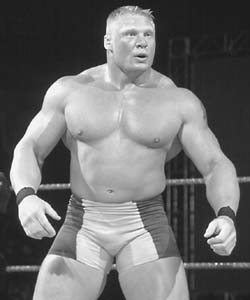
An early day Brock Lesnar. SlamWrestling file photo
On the surface, you can’t argue with NXT’s success. According to WWE, almost 90% of the participants in last year’s WrestleMania were developed under the NXT banner. Understanding that there are only ever a few top spots in the pro wrestling business, I would argue that as a training ground, NXT’s results have been mixed at best. For years, WWE has leaned heavily on the few superstars it created, while most of the roster seems interchangeable. Fans may clamor for more, or different, or more diverse, and occasionally someone breaks through temporarily (like Big E or Daniel Bryan), but WWE’s main events have been dominated by an increasingly boring few. WWE’s last bumper crop of talent preceded NXT. Younger fans might be surprised to learn that the likes of John Cena, Randy Orton, Brock Lesnar and Batista all fought together in OVW before they dominated WWE main events for the better part of 20 years. OVW still exists under different ownership (Al Snow has recently parlayed his attempts to keep the promotion alive into a well-reviewed Netflix series).
In the wake of this week’s announcement, WWE CEO Nick Khan has stated that going forward NXT can function as both a developmental system and a third brand — a balancing act which has proven difficult to date.
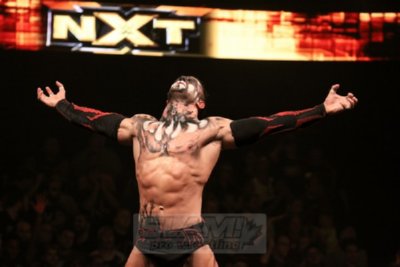
Finn Balor in NXT
As a developmental territory, NXT arguably works best as a finishing school where experienced independent stars can marry the skills that attracted WWE’s attention to the promotion’s expectations as to how a match should go — or to fill in any holes in their game. Fans who appreciated stars like Keith Lee, Karrion Kross, the Undisputed Era, #DIY or Sami Zayn and Kevin Owens would argue that none of these wrestlers needed NXT’s help but they did benefit from the foot in the door. A quick look at NXT champions from 2014 to 2022 shows NXT’s top prize shuttling between international (Finn Balor, Adrien ‘PAC’ Neville, Shinsuke Nakamura, Aleister Black, Andrade ‘Cien’ Almas), independent (Tommaso Ciampa, Johnny Gargano) and ROH/Impact veterans (Samoa Joe, Owens and Zayn, Bobby Roode, Adam Cole (BAY BAY!) Drew McIntyre, Kross). It seems that WWE’s most successful main stars are those who gained extensive experience elsewhere (or, as in the case of Cody Rhodes or Roman Reigns, who grew up in the business). During the pandemic, WWE leaned hardest on wrestlers like Drew McIntyre and Bobby Lashley — both of whom had left WWE years before and returned as more complete performers.
The above-cited NXT champions have had mixed main roster success, but in my view that speaks more to frequent creative failures and an unwillingness to use what worked in NXT than to the quality of these wrestlers’ performances.
To be honest, I have trouble seeing that time spent in NXT enhanced these wrestlers’ careers compered to say, AJ Styles, who debuted at the 2016 Royal Rumble straight from NJPW. WWE’s reliance on NXT may contribute to an older, more injury-prone roster. The artificially indy environment of the Performance Center may also take the shine off acts who may be established elsewhere, but are new to the WWE Universe.
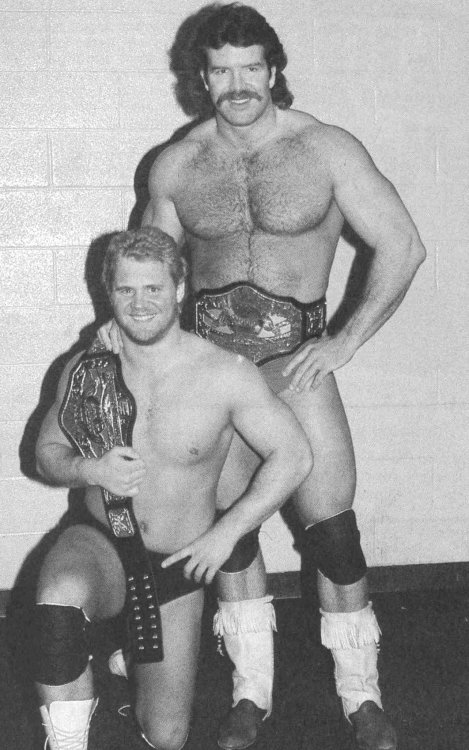
Curt Hennig and Scott Hall as AWA tag team champions.
Growing up, a wrestler’s arrival on WWE Superstars of Challenge or Maple Leaf wrestling was cause for excitement. Some repackaged wrestlers would be introduced via a series of vignettes which established their new characters. These vignettes were memorable in their own right, like Curt Hennig displaying a range of ‘perfect’ athletic feats, or Dusty Rhodes in a blood-spattered apron daring us to “beat his meat.”
A debut could feed a wrestler directly into his or her first storylines. Randy Savage and Bam Bam Bigelow were wooed by the WWF’s resident heel managers before they set foot in the ring. Both men added to their notoriety by rejecting the likes of Fred Blassie, Bobby Heenan or Mr. Fuji in favor of their own seconds. In Savage’s case, it was his legendary pairing with Ms. Elizabeth. In Bigelow’s case it was his less-than-legendary pairing with a scepter-wielding Sir Oliver Humperdink. Ric Flair and Bobby Heenan’s ‘Real World Champion’ vignettes featuring an absconded NWA World championship belt might be the best example.
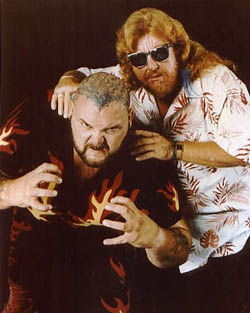
Bam Bam Bigelow and Sir Oliver Humperdink
Sometimes, no introduction was necessary. I vividly remember the Ultimate Warrior charging onto my TV screen on a random Saturday, or the Legion of Doom (as the Road Warriors had been rechristened) simply announced as competing on the next week’s broadcast.
For experienced performers, NXT feels like a bit of a spoiler. You know it’s only a matter of time before these acts go to the main roster, but by the time they get there you’ve also seen them in a WWE ring working a WWE match … so the surprise that was integral to our fandom up through the late 1990s Monday Night Wars is gone.
It is telling that WWE’s biggest ‘get’ since AEW was formed is Cody Rhodes. His WWE return took place at WrestleMania without a developmental detour. More recently, WWE has signed Jade Cargill and Brian Pillman, Jr. Cargill has yet to appear in a wrestling role, and Pillman is starting to make waves on NXT. In fairness, he was barely used in AEW outside of a middling tag team and a single, super-hot match against MJF in front of a hometown Cincinnati crowd.
I would feel better about NXT’s success in getting wrestlers ready for the biggest stage of their career if it felt like there were effective communication between that brand and RAW and SmackDown. As a fan, it is dispiriting to see performer after performer called up to the main roster, only for them to be mishandled and ignored. Triple H was widely praised for his work in developing characters and getting the most out of his performers, only for this work to be lost in translation before a wider audience. The most successful call-ups, like the late Bray Wyatt or Charlotte Flair, started with the characters they established in NXT and evolved them to suit a bigger audience or roster needs. Less successful acts like the Ascension, the Authors of Pain or Karrion Kross in his first go-round, were stripped of the best parts of their acts — whether it was a spooky aura of invincibility, a Hall of Fame manager in Paul Ellering, or the best entrance this side of The Undertaker (to be replaced by a truly baffling Roman Gladiator ensemble and an opening night squash loss to Jeff Hardy).
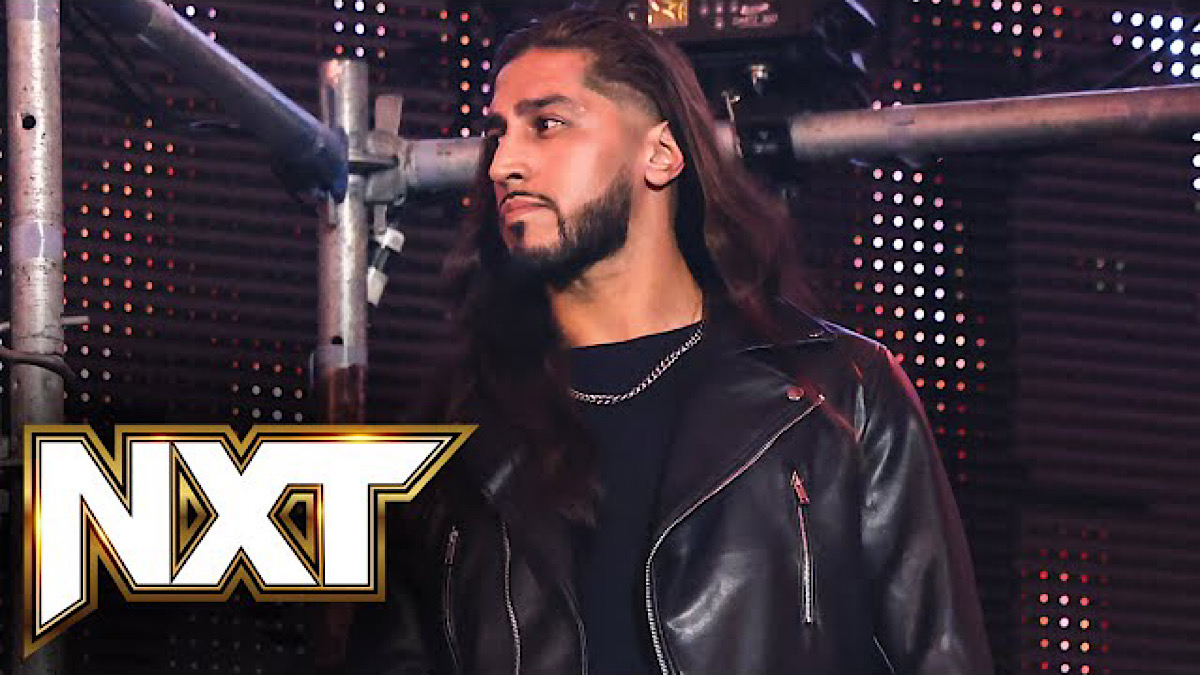
Mustafa Ali
I hope this will get better but note that following the recent wave of call-ups WWE held one of its periodic pruning sessions. Apart from the usual criticism that if Creative can’t find a use for talent, the onus should be on Creative to do its job better, it’s worth noting that several NXT wrestlers were released, including some like Mustafa Ali, who were actively involved in programs. Given Triple H’s closeness to current NXT head Shawn Michaels (who seemed surprised by the decision) I wonder whether those releases reflect a lack of communication between brands, or broader issues with wrestlers who take to social media to complain about their spots.
Of course, veteran wrestlers’ repackaging is nothing new. Curt Hennig has a middling early 1980s run before he became Mr. Perfect. Ted DiBiase was the WWF North American champion long before he hoisted the Million Dollar belt. The barnstorming, bloodthirsty Kiwi Sheepherders mellowed considerably once they got paid, becoming the lovable Bushwhackers. Ricky Steamboat became a Styrofoam dragon. The Iron Sheik was no less a traitor than Sgt. Slaughter — he switched sides from his native Iran to back Iraq as Colonel Mustafa (never mind that Iraq and Iran fought an eight-year war). Hulk Hogan’s high profile 1980 heel run was retconned out of existence when he took Bob Backlund’s spot at Madison Square Garden to become WWF champ. But all of these changes are accepted as part of wrestling’s suspension of disbelief. There’s an unwritten, intellectual property-driven rule that when you go from one territory or company to another, you check your old identity at the door. That’s a tougher argument to make when the doors exist within the same company in adjacent time slots. As a fan I can accept a character change or heel turn, but I need some kind of backstory. Too many wrestlers moved from NXT to RAW or SmackDown without concern for who they were or how they got there — it hurt them and diminished the product’s credibility as a whole.
Even worse, some wrestlers seem to be brought up without any plans for to be used on the main roster. They hang around in crowd scenes, lose occasional matches on Main Event and are released with little notoriety (and often no recognizable name) to capitalize on elsewhere. If WWE is more judicious about hiring talent in the first place, it would give other promotions a greater, untainted talent pool to work with — and crucially — develop outside WWE’s spotlight. By the time those wrestlers would get to WWE they would be more polished, with greater experience working in front of diverse audiences and better able to run with whatever Triple H and Creative throw at them.
I suspect that at points WWE has gone on hiring jags as a way of taking talented performers ‘off the board’, making them unavailable to competition like Impact (which at one point was stronger) or AEW. But holding on to talent without a clear plan destroys career momentum and can’t be an effective use of WWE’s vast resources. Better to give wrestlers like Keith Lee, EC3, Chelsea Green (who has since returned and is getting pushed as the WWE Women’s Tag Team champion, but only after being released and working elsewhere, like McIntyre or Lashley) or Bobby Roode (who was injured and currently works in production) the space to work and develop on their own, rather than sitting at home or backstage.
In May 2023, WWE held its most recent ‘draft’. NXT figured prominently, as a number of stars were moved to RAW and SmackDown (and some main roster talent was drafted back to NXT). NXT wrestlers were drafted as follows:
SmackDown:
- Pretty Deadly
- Cameron Grimes
- Grayson Waller
RAW:
- JD McDonagh
- Zoey Stark
- Indi Hartwell
- Alba Fyre and Isla Dawn
- Apollo Crews (not really a fair comparison, since he’s already had RAW and SmackDown runs before moving back to NXT)
- Kayden Carter and Katana Chance
- Indus Sher (2/3 of whom have already had substantial main roster runs)
- Odyssey Jones
Free Agents:
- Von Wagner (who seems to be set in NXT for the next while)
- Xyon Quinn (Who? Where? What?)
Like any sport, a draft class will yield a mix of more and less successful members, but watching these talents in the six months or so since their debuts, it’s hard to see any as gamechangers. Some, like Fyre and Dawn, Jones or Quinn, have barely appeared since they were drafted. Those who are succeeding, like Pretty Deadly or Grayson Waller, are doing so because they’re expanding on the acts they developed in NXT — and earlier in their careers. It helps that WWE is insistently pushing these three, along with Zoey Stark, who’s gone from a top-line feud alongside Trish Stratus against Becky Lynch to a title shot against Rhea Ripley at the coming Survivor Series event. Some, like Grimes, may simply have been promoted because despite their obvious talent, they’ve run their course in NXT and it’s worth seeing if they can break through before they get released. Grimes’ hyper-regional gimmick works against him, along with the fact that he reminds me of Nick Dinsmore’s old Eugene character … but then LA Knight rescued his career from his misbegotten post-NXT introduction as Maximum Male Manager Max Dupree, so anything is possible.
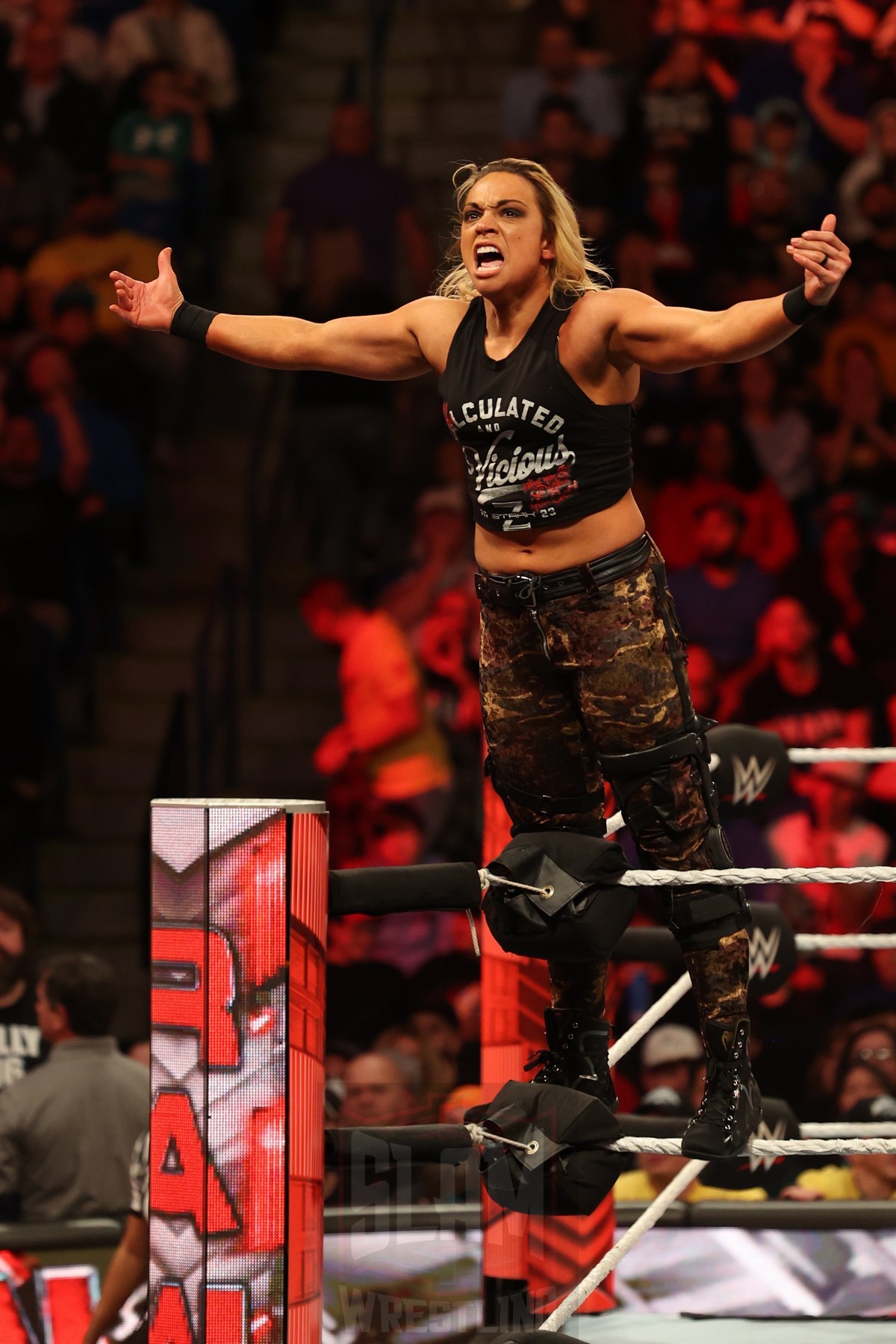
Zoey Stark wins the Women’s World Championship Number One Contender Battle Royal at WWE Monday Night Raw on November 6, 2023, at the Mohegan Sun Arena at Casey Plaza in Wilkes-Barre, PA. Photo by George Tahinos, https://georgetahinos.smugmug.com
Even more recently, the Creed Brothers and Ivy Nile debuted on Monday Night Raw, signing their first ‘official’ contracts to be part of that show. They fall into the same pattern. They’re athletic but aimless, and their acting skills need considerable work. WWE’s tag team division is likely stacked enough to support them for a while, but while it’s clear NXT has taught them to wrestle professionally, if this is as far as development goes something is missing.
Part of Nick Khan’s argument that NXT can develop talent and function on its own may reflect the increased porousness of the NXT and main rosters. Bron Breakker’s NXT title reign was bifurcated by a blink-and-you’ll-miss-it Dolph Ziggler victory. Dominik Mysterio (who also bypassed NXT his first time around) is now a two-time NXT North American champion and he carries that belt with him on RAW and SmackDown. Charlotte Flair and Becky Lynch both went back down to the farm to claim an NXT Women’s Championship. The ease with which main roster talents beat their NXT opponents sends the wrong message to the audience and makes the climb up the main roster ladder that much harder. In the meantime, the real up-and-comers are abetted by reclamation projects like Drew Gulak, Dijak, Baron Corbin or Apollo Crews (who still seems to be hanging around NXT despite being drafted to RAW, like George Costanza returning to his office the day after he quit).
If NXT were a fully independent brand outside the main roster universe, this would be great. As it is, the trip to NXT feels too much like a demotion to do those wrestlers any good. I’d much rather see Dijak and Corbin teamed up with Kross on the main roster, either whenever the Judgment Day starts turning over its current members or on their own as a goth version of the Freebirds. If veteran WWE talent is useful behind the scenes and is helping prepare younger NXT stars for what to expect in the next phase of their careers, I’m all for it. I’m not yet seeing it on my screen. Maybe that’s by design.
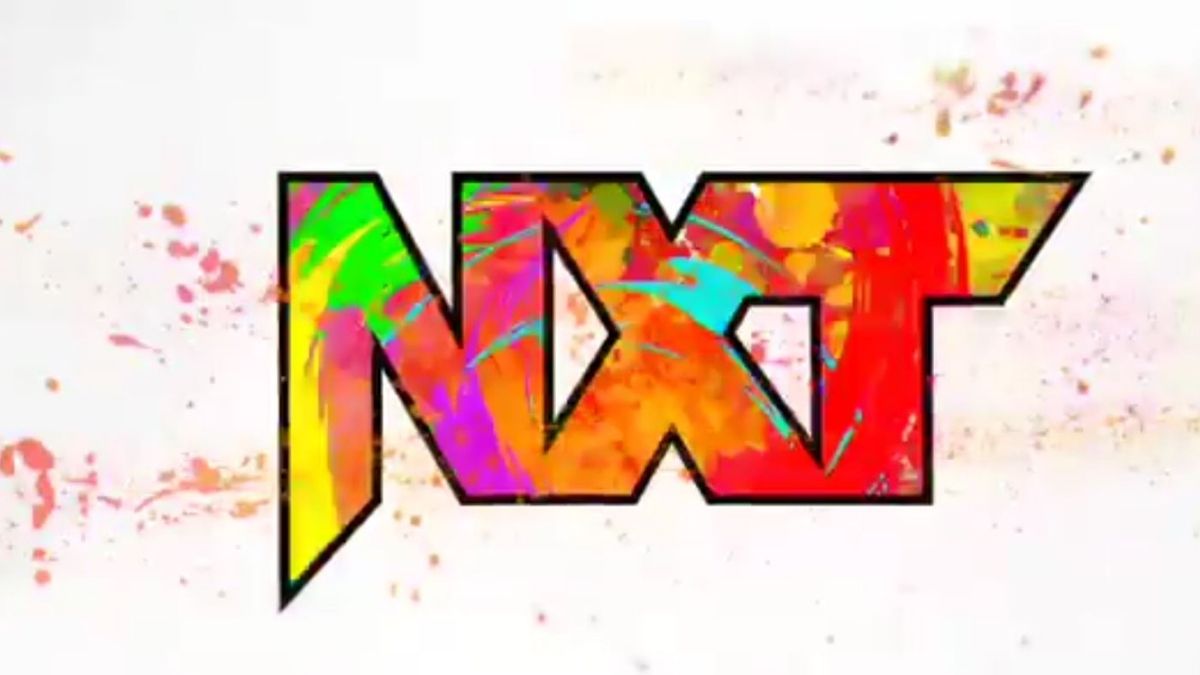
The NXT 2.0 logo
One hallmark of Vince’s latter-day influence over NXT (especially during the 2.0 regime) was to move away from the established independent talent preferred by Triple H, with a goal of creating WWE superstars from the ground up. Vince has infamously sought to recruit younger athletes and imposed a 30-year age cap on new signings. Instead of plucking talent from a resurgent independent wrestling scene, or from WWE’s closest competitors, the promotion is aggressively hiring talent directly from college, creating a generation of wrestlers built entirely in Vince’s image … until he was turfed, that is.
I acknowledge that an aging roster can be a problem, though I have argued that in keeping talent in NXT they may be hurting the cause. In any case it remains to be seen how this strategy will work. WWE’s most high-profile collegiate athlete was Gable Steveson, an Olympic gold medalist like Kurt Angle, but one who unlike Angle seems to be having trouble committing to the pro circuit or grasping its intricacies.
And, here’s the thing: TV deals notwithstanding, in a perfect pro wrestling world, NXT would not exist. A robust scene where healthy competition doesn’t mean putting rivals out of business would guarantee a supply of polished, camera-ready talent without the creativity-crushing control exerted by McMahon over his roster. As mentioned, NXT was born because WWE put everyone else out of business. Without places for successive generations of wrestlers to train or work, WWE nearly put itself out as well.
NXT worked best when it inhabited its own universe, mostly unmentioned on the big show broadcasts. Its scope was not and is not big enough to give wrestlers the varied exposure they need to develop as complete performers, much less to turn an untrained athlete into a full-fledged pro wrestler (celebrity exceptions like Bad Bunny or current US Champion Logan Paul put time in at the Performance Centre but were hired because of their charismatic performances in their own fields, along with their inherent athleticism. They also receive extensive private training from the likes of Michaels, which rank-and-file rookies do not receive).
I wouldn’t turn down the millions offered by the CW to put on a show either. Being mindful of quality and NXT’s role in fostering talent, I would have liked to see other promotions like the NWA get that shot. With utmost respect, the next face of the WWE is more likely to come through Corgan’s promotion (which hires younger talent when they’re less expensive alongside grizzled veterans), AEW or Impact. This has always been the case. The WWF that ruled the 1980s was built by raiding other promotions. Hulk Hogan came from the AWA. Junkyard Dog from Mid-South. Roddy Piper from the Carolinas. I can go on. The WWF that won the Monday Night Wars built a formidable roster from WCW castoffs like Stunning Steve Austin, Cactus Jack, Mean Mark Callous and Terra Ryzing.
If I look at many promotions that I and other grown up fans have enjoyed, I think that being part of a niche audience has become important. There’s a feeling that even within a corporate juggernaut, following a smaller, plucky promotion which emphasizes something different than the WWE-defined ‘mainstream’ makes the show more fun. ECW courted this kind of loyalty, even if it stymied their growth on a bigger stage. People still pine for the alternate takes offered by Wrestling Society X or Lucha Underground. Some AEW fans define themselves as explicitly not following WWE, and vice versa (I think that’s silly, as good wrestling is welcome no matter who’s offering it). And that’s where NXT has succeeded — within the WWE Universe yet separate from it — a microcosm of the macrocosm, as a certain BMF might say. I’m not sure I agree that NXT will thrive trying to stand on its own while feeding the larger sports entertainment beast. Wrestling on its grandest stage is indeed big business, and decisions are made that affect what we get to see-the performers who grace our screens, the characters they play, the promos they scream and the moves they get to perform.
I’m just glad that as NXT grows, there are plenty of alternatives out there. I think if pro wrestling is to stay healthy, we’ll need them more than ever.
RELATED LINK
